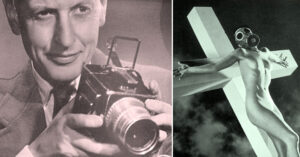
This picture from 1958 was entitled “Probably the most widely seen eye in the world.” The eye belonged to the Mayor of Chelsea’s mace bearer and featured in posters and publicity for Michael Powell’s ill-fated film Peeping Tom, which more or less ended the director’s UK career. The photo is by John Bignell, who took the pictures of Desiree in previous posts of mine.
The photo won the top prize for the Movie Promotion Still of 1960. In an interview in Figure Quarterly Bignell said:
“Any commercial photographer given this assignment might have come up with the hackneyed idea of an eye looking through a keyhole. My idea was to show an eye with some surrounding flesh in shadow and the shape of an illuminated keyhole falling across it.”
“I knew this would look good — if only I could find an eye that was sufficiently bloodshot and laden with lust and lechery. This was quite a problem.”
For a couple of weeks, Bignell walked around staring into people’s faces and embarrassing his studio visitors with the penetrating scrutiny he subjected their eyes to. He had almost given up in despair when he went home one day and found a visitor waiting for him — a benign, elderly gentleman who was the family’s solicitor. Shaking him by the hand, Bignell looked into his eyes. Suddenly, the photographer trembled with excitement. “Why, you randy old coot!” he hooted. The man’s monocle dropped to the end of its silk. “I — I beg your pardon, John.” he gasped. A moment later, he was hurried down the street to Bignell’s studio while the photographer soothed him with such explanations as, “This is sensational. You have the dirtiest eye in London. The visual expression of debauchery and low cunning.” The old boy was, in fact, suffering from a slight cold in the eye, and after he understood what was wanted of him and that his identity would remain secret, he became an enthusiastic ham, leering into Bignell’s lens for shot after shot. “I admit that there’s a lot of satisfaction in turning out a shot like Peeping Tom,” Bignell muses, “but I hardly ever feel really enthusiastic about a commercial assignment unless it contains some aspect of the nude.”
On the back of one print of the picture, Bignell has written a reference to Susan Sontag’s book On Photography, even noting the page number in the Penguin edition of the mention of Peeping Tom. There’s nothing particularly illuminating there, but perhaps Bignell wanted to remind anyone who read the caption that someone thought the film was a serious piece of work. There seems to have been a lot of moral panic about it when it first came out, which seems almost inexplicable in the light of what we’ve seen since. Following John Bignell’s lead, I refer you to David Pirie’s A New Heritage of Horror: the English Gothic Cinema for an account of the film and its reception.
A big thank you to Dave Walker, the local studies librarian, over at the Kensington Central Library, for this post.
Peeping Tom is available to buy from Amazon.




